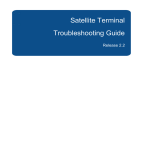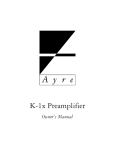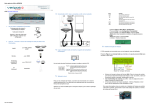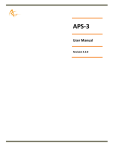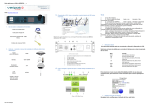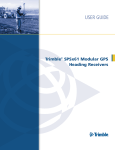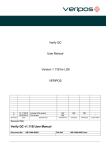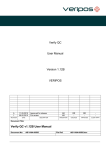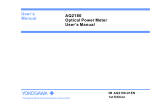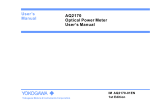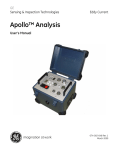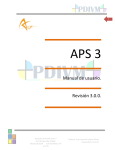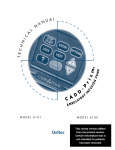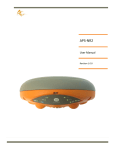Download LD5 Installation Manual - downloads
Transcript
LD5 Installation Manual VERIPOS Date: 05.06.2015 Procedure Title: File Ref.: LD5 Installation Manual AB-V-MA-00540 29.07.2013 13.06.2013 12.04.2013 Antenna & data output info updated Minor changes Minor revisions following review Updated antenna information & formatting changes Add Mod1 & Mod 2 info Amend to add A420/1 antenna Revised for A2 and A3 mod1 DATE DESCRIPTION B4 22.09.2015 B3 B2 01.07.2015 05.06.2015 B1 05.05.2015 B 1c 1b REVISION AR RR RR - AR AR RR RR RR RR - AR RP - - AW AW AW AW AW AW EM EM - - ORIGINATOR CHECKED APPROVED CLIENT APPR Procedure Title: LD5 Installation Manual File Ref: Rev No: B4 AB-V-MA-00540 Page 2 Procedure Title: File Ref.: LD5 Installation Manual AB-V-MA-00540 CONTENTS 1. INTRODUCTION................................................................................................................................... 5 1.1 GENERAL ........................................................................................................................................ 5 1.2 LD5 INTEGRATED MOBILE............................................................................................................ 5 1.3 SCOPE............................................................................................................................................. 6 1.3.1 1.4 TERMS AND ABBREVIATIONS ...................................................................................................... 7 1.5 LD5 SAFETY SUMMARY ................................................................................................................ 9 1.6 1.5.1 Unpacking and inspection ................................................................................................ 9 1.5.2 Safety symbols ................................................................................................................. 9 1.5.3 Safety warnings ................................................................................................................ 9 1.5.4 Installation....................................................................................................................... 10 1.5.5 Maintenance ................................................................................................................... 10 1.5.6 Servicing ......................................................................................................................... 10 1.5.7 Fault diagnosis ............................................................................................................... 10 DOCUMENT CONVENTIONS ....................................................................................................... 11 1.6.1 Typographical conventions .............................................................................................. 11 1.6.2 Special Notices ............................................................................................................... 11 1.7 REFERENCES .............................................................................................................................. 11 1.8 WASTE ELECTRICAL AND ELECTRONIC EQUIPMENT ........................................................... 12 1.9 DISCLAIMER ................................................................................................................................. 13 2. LD5 SYSTEM DESCRIPTION ............................................................................................................ 15 2.1 LD5 RECEIVER............................................................................................................................... 15 2.2 3. 2.1.1 Examples of LD5 variants............................................................................................... 16 2.1.2 Installation....................................................................................................................... 17 CONTROLS, CONNECTORS AND I/O PORTS ............................................................................... 18 2.3 2.2.1 Front Panel ..................................................................................................................... 18 2.2.2 Rear panel ...................................................................................................................... 19 2.2.3 Serial ports...................................................................................................................... 20 2.2.4 Ethernet Interfaces ......................................................................................................... 21 SCOPE OF SUPPLY ..................................................................................................................... 22 2.3.1 Antennas ......................................................................................................................... 22 2.3.2 Coaxial questions ........................................................................................................... 22 INSTALLATION .................................................................................................................................. 23 3.1 3.2 Rev No: Contents ........................................................................................................................... 6 B4 INSTALLATION ............................................................................................................................. 23 3.1.1 LD5 Installation – Schematic Examples ......................................................................... 23 3.1.2 Ventilation Requirements ............................................................................................... 26 3.1.3 LD5 Siting Guides ........................................................................................................... 26 ANTENNA INSTALLATION ........................................................................................................... 26 Page 3 Procedure Title: File Ref.: 3.3 LD5 Installation Manual AB-V-MA-00540 3.2.1 Antennas ......................................................................................................................... 27 3.2.2 GNSS Antenna ............................................................................................................... 27 3.2.3 L-Band Antenna .............................................................................................................. 30 3.2.4 MF Beacon Antenna ....................................................................................................... 32 COAXIAL CABLE INSTALLATION ................................................................................................ 33 3.3.1 Maximum recommended cable lengths .......................................................................... 33 3.3.2 General ........................................................................................................................... 34 3.4 COAXIAL CABLES TO ANTENNAS ............................................................................................. 36 3.5 INTERFACE ................................................................................................................................... 37 3.6 3.5.1 LD5 Rear connections .................................................................................................... 37 3.5.2 Ethernet interface ........................................................................................................... 38 3.5.3 Interface cabling ............................................................................................................. 39 EQUIPMENT RACK ....................................................................................................................... 40 3.6.1 3.7 4. Rack installed LD5 – Guidance ...................................................................................... 41 POWER AND CABLING ................................................................................................................ 42 REFERENCE INFORMATION ................................................................................................................................ 43 4.1 LD5 TECHNICAL SPECIFICATIONS ............................................................................................ 43 4.2 4.1.1 Mechanical ....................................................................................................................... 43 4.1.2 Environmental .................................................................................................................. 43 4.1.3 Safety considerations ..................................................................................................... 43 4.1.4 Electrical .......................................................................................................................... 44 4.1.5 Compass safe distance .................................................................................................... 44 4.1.6 Specification of Antennas ............................................................................................... 44 4.1.7 Legacy Antennas ............................................................................................................ 46 4.1.8 Summary Specifications of Module Receiver Cards ...................................................... 51 CABLING AND CONNECTORS .................................................................................................... 55 4.3 4.2.1 Interface and serial port information ............................................................................... 55 4.2.2 Power connection to the LD5 ......................................................................................... 56 4.2.3 DC power ........................................................................................................................ 57 4.2.4 Times LMR 400 .............................................................................................................. 57 4.2.5 Times LMR 240 .............................................................................................................. 59 4.2.6 LMR 400 – Times Microwave TC-400-NM N-type male connector ................................ 60 4.2.7 LMR400 – Times Microwave TC-400-TM TNC male connector .................................... 65 INTERFACE AND SERIAL PORT INFORMATION ....................................................................... 65 4.3.1 5. Rev No: LD5 COM ports ............................................................................................................... 65 CONTACT INFORMATION ................................................................................................................ 66 5.1 VERIPOS HELPDESK ................................................................................................................... 66 5.2 VERIPOS OFFICE LOCATIONS ................................................................................................... 66 B4 5.2.1 VERIPOS UK .................................................................................................................. 66 5.2.2 Additional VERIPOS offices ............................................................................................ 66 Page 4 Procedure Title: File Ref.: LD5 Installation Manual AB-V-MA-00540 1. INTRODUCTION 1.1 GENERAL This document provides the information required to install a VERIPOS LD5 IMU. When consulting this document it will help the installer to have available the following items to assist in assessing and planning the work: 1.2 VERIPOS LD5 and associated equipment shipped to site ‘Equipment Packing list’ (included with the equipment packing sent to site) LD5 Operations manual VERIPOS document “Antenna and Coaxial Cable Installation” provided with VERIPOS installation documentation Interactive training modules and VERIPOS product literature available at http://help.veripos.com. LD5 INTEGRATED MOBILE The VERIPOS LD5 IMU is easy to install and operate. It is an effective, flexible unit that ensures reliable reception of VERIPOS services with superior positioning from metre to decimetre level accuracy. It is designed as a standardised, upgradeable L-band receiver that is simple to operate and maintain. The LD5 can be upgraded as required to generate VERIPOS proprietary position solution depending on the data subscriptions enabled. LD5 variants may be used as a sensor to output received data and GNSS measurements to external processing or quality control software such as the VERIPOS QC. The LD5 has a 3.5” (9 cm) colour screen that allows quick and easy user setup. The LD5 is extremely flexible. Operating status is determined using the front panel display. Rev No: B4 Page 5 Procedure Title: File Ref.: LD5 Installation Manual AB-V-MA-00540 1.3 SCOPE The purpose of this manual is to provide the necessary information to perform the installation of the VERIPOS LD5 Integrated Mobile Unit. It covers installation of: Antennas Coaxial and data cables LD5 receiver and power requirement Housings and ancillary equipment provided with the LD5. 1.3.1 Contents This manual provides guidance for engineers to install a VERIPOS LD5 receiver on to a vessel. Details are provided to assist in locating and connecting equipment ready to be commissioned. Read this manual in conjunction with the specific ‘Scope of Supply’ or Equipment Packing List’ for your particular installation. Chapter Contents 1. Introduction - This chapter specifies the purpose and target group for the manual. It also contains a list of used abbreviations and a specification of the document conventions. 2. System description - This chapter describes the interface in detail on the front and back side of the LD5 unit as well as LD5 technical data. 3. Installation - This chapter covers the installation of the LD5 unit as well as cabling guidelines. 4. Reference information - This chapter comprise additional information such as Safety check list, cable specifications, parts list and a description of LD5. 5. Contact information - This chapter contains contact information details about the VERIPOS Helpdesk and VERIPOS offices world-wide. Rev No: B4 Page 6 Procedure Title: File Ref.: LD5 Installation Manual AB-V-MA-00540 1.4 TERMS AND ABBREVIATIONS Apex Apex² BER CoG CR DGPS DGNSS DOP DP EGNOS GDOP GLONASS GPS GNSS HDOP IMU KPH LAN LF LNA L-Band LCD LD5 LVTTL MF MMI MPH m/s MSAS NMEA PDOP PPP PPS PRN RMS RTCM SBAS SD Rev No: B4 A VERIPOS High accuracy PPP positioning system using GPS A VERIPOS High accuracy PPP positioning system using GPS and GLONASS Bit Error Rate Course over Ground Carriage Return Differential GPS Differential GNSS Dilution of Precision Dynamic Positioning European Geostationary Navigation Overlay System Geometry Dilution of Precision GLObal NAvigation Satellite System – Russian equivalent to GPS Global Positioning System Global Navigation Satellite System Horizontal Dilution of Precision Integrated Mobile Unit Kilometres per Hour Local Area Network Line Feed Low Noise Amplifier A radio frequency band used to transmit correction data to mobile users Liquid Crystal Display A VERIPOS unit available with GNSS, Demodulator and Beacon cards Low Voltage Transistor Transistor Logic Medium Frequency band used to transmit IALA Beacon Correction Data Man Machine Interface Miles per Hour Metres per Second Multi-functional Satellite Augmentation System National Marine Electronics Association Positional Dilution of Precision Precise Point Positioning Pulse per Second Pseudo Random Noise Root Mean Square Radio Technical Commission for Maritime Services Satellite Based Augmentation System Standard Deviation Page 7 Procedure Title: File Ref.: LD5 Installation Manual AB-V-MA-00540 SDRAM SNF SNR Spotbeam Standard (Std) Standard² (Std²) SV Ultra Ultra² USB UTC VDOP VGA VOSS WAAS WEEE Rev No: B4 Synchronous Dynamic Random Access Memory Signal Notification Form Signal to Noise Ratio High Power L-Band Signal VERIPOS Single frequency (L1) DGPS system VERIPOS Single frequency (L1) DGNSS system (GPS + GLONASS) Space Vehicle A VERIPOS High accuracy PPP positioning systems using GPS A VERIPOS High accuracy PPP positioning system using GPS and GLONASS Universal Serial Bus Coordinated Universal Time Vertical Dilution of Precision Video Graphic Array VERIPOS Online Support System Wide Area Augmentation System Waste Electrical and Electronic Equipment Page 8 Procedure Title: File Ref.: LD5 Installation Manual AB-V-MA-00540 1.5 LD5 SAFETY SUMMARY This section summarizes safety guidelines when installing the LD5 unit. 1.5.1 Unpacking and inspection Carefully unpack the unit and retain packaging to return the equipment where required. Inspect the unit. If the equipment appears damaged return it using the original packaging. Responsibility for damage is not accepted if the approved packaging is not used. Ensure all items and ancillary equipment is present. Contact your supplier or VERIPOS where this is not the case (see contacts in the Contact information chapter). 1.5.2 Safety symbols Please see section 1.6 Document conventions later in this manual. 1.5.3 Safety warnings Always observe the following safety precautions: Rev No: B4 Disconnect power from power supply to isolate the equipment before working on it. Ensure adequate air circulation to ventilate the unit especially to the sides to avoid heat build-up. The LD5 unit is class 1 construction and must be grounded. Connect only to a power supply with a voltage corresponding to that marked on the unit. Always disconnect the LD5 and associated equipment from the power supply when connecting equipment. The equipment is for use in moderate climates only. Never use the equipment in damp or wet conditions. Avoid excessive heat, humidity, dust and vibration. Do not use where the equipment may be subjected to dripping or splashing liquids. Always use the power connections supplied with the unit. See the Reference information chapter for details. Before replacing a fuse, disconnect the equipment from power supply. Page 9 Procedure Title: File Ref.: LD5 Installation Manual AB-V-MA-00540 1.5.4 Installation Ensure the DC power supply is disconnected during installation. The power connection is easily accessed on the rear of the unit. Ensure that the unit is secured using the holes in the base plate. Position the unit to ensure there is ample spacing for ventilation of the unit and access to front and rear during normal operation. Ensure all cables are routed safely to avoid sharp edges, bends and pinches. Ensure only the specified cables are used for interconnection of the equipment. Permanently connect the vessels’ protective earth to the protective bonding connection on the unit. 1.5.5 Maintenance Clean the unit using a clean dry cloth only. Do not wet the unit or allow moisture to penetrate the unit. Do not use solvents to clean the unit. 1.5.6 Servicing This unit contains no user-serviceable parts. Please refer all repairs to a qualified service agent or to VERIPOS. See the Reference information chapter for details. 1.5.7 Fault diagnosis Follow the guidance in this document to correctly install the LD5. Where the LD5 does not perform as indicated please first check all connections before contacting your supplier or VERIPOS for assistance (contact details in the Contact information chapter). Rev No: B4 Page 10 Procedure Title: File Ref.: LD5 Installation Manual AB-V-MA-00540 1.6 DOCUMENT CONVENTIONS 1.6.1 Typographical conventions Italic or bold text is used to emphasize certain parts of the information. Italic is also used in cross-references to other parts of the document. Bold text is also used for indicators and touch screen “push-buttons” commands. “Text within quotes” is used when display screens are mentioned in text. Monospace text is used for input/output strings to/from the device. 1.6.2 Special Notices 1.7 REFERENCES Please read this manual and refer to the following information where required: VERIPOS document “Antenna & Coaxial Cable Installation”. LD5 Operations manual LD5 Quick Guide. Information is available at VERIPOS Online support system (VOSS): http://help.veripos.com Rev No: B4 Page 11 Procedure Title: File Ref.: LD5 Installation Manual AB-V-MA-00540 1.8 WASTE ELECTRICAL AND ELECTRONIC EQUIPMENT The Waste Electrical and Electronic Equipment Directive (hereinafter referred to as the “WEEE directive”) places an obligation on EU-based manufacturers, distributors, retailers and importers to take-back electronics products at the end of their useful life. A sister directive, RoHS (Restriction of Hazardous Substances) complements the WEEE directive by banning the presence of specific hazardous substances in the products at the design phase. The WEEE directive covers all VERIPOS products imported into the EU as of August 13, 2005. EU-based manufacturers, distributors, retailers and importers are obliged to finance the costs of recovery from municipal collection points, reuse, and recycling of specified percentages per the requirements contained in the WEEE Directive. Instructions for disposal of WEEE by users in the European Union. Products which have the undernoted symbol located on either the product itself or its packaging indicates that the product must not be disposed of with other waste. Instead, it is the user’s responsibility to dispose of the product by handing it over to a designated collection point for the recycling of WEEE. The symbol shown below is on the product or on its packaging, which indicates that this product must not be disposed of with other waste. Instead, it is the user’s responsibility to dispose of their waste equipment by handing it over to a designated collection point for the recycling of waste electrical and electronic equipment. The separate collection and recycling of your WEEE at the time of disposal will help to conserve natural resources and ensure that it is recycled in a manner that protects human health and the environment. For more information about recycling centres, please contact the local city office, the household waste disposal service or the product supplier. Rev No: B4 Page 12 Procedure Title: File Ref.: LD5 Installation Manual AB-V-MA-00540 1.9 DISCLAIMER VERIPOS accepts no responsibility for any damage or injury to the system, ship or personnel caused by drawings, instructions or procedures not prepared by VERIPOS. Veripos Limited (hereinafter referred to as “Veripos”) has taken every care in the preparation of the content of this Operation Manual (“Manual”). This Manual is provided “as is” without any representations or warranties, express or implied. Veripos makes no representations or warranties in relation to this Manual and the content provided herein. Veripos reserves the right at its sole discretion, but without any obligation, to make amendments or improvements to, or withdraw or correct any error(s) or omission(s) in any portion of the Manual without notice. Although Veripos makes a reasonable effort to include accurate and up to date information, Veripos does not warrant or guarantee that this Manual and its contents are current, complete, accurate and/or free from errors. Copyright © 2004-2015 VERIPOS All rights reserved. No part of this Manual and its contents may be reproduced, copied, re-engineered, adapted, redistributed, published, commercially exploited or transmitted in any form, by any means, electronic or mechanical, including photocopying or recording, without the express prior written permission of Veripos. Applications for any written permission should be addressed to Veripos House, 1B Farburn Terrace, Dyce, Aberdeen, AB21 7DT, United Kingdom. Unauthorised reproduction, copying, re-engineering, adaption, redistribution, publication or commercial exploitation of this Manual or its contents may be subject to civil as well as criminal sanctions under the applicable laws. Where Veripos’ intellectual property rights are alleged to be infringed by the end user, Veripos will seek to enforce its intellectual property rights in the civil courts to the fullest extent possible. Where reproduction, copying, re-engineering, adaption, redistribution, publication or commercial exploitation of this Manual or its contents has been permitted by Veripos in accordance with this disclaimer, then no changes in the Manual or deletion of any kind to the Manual will be made by end user. End user acknowledges that it does not acquire any ownership rights by accessing, viewing or utilising this Manual and agrees that it shall not hold itself out to any third party as having any ownership rights to this Manual. The end user shall save, indemnify, defend and hold Veripos harmless on written demand, from all claims, losses, damages, costs (including legal costs), expenses and liabilities of any kind and nature, invoked against Veripos by any third party, for or arising out of, any alleged infringement of any patent or proprietary or protected right arising out of or in connection with the utilisation of this Manual by the end user and/or in connection with any representation to third parties of ownership of any kind with respect to this Manual by the end user. To the fullest extent permitted by applicable laws, Veripos hereby excludes liability, for Rev No: B4 Page 13 Procedure Title: File Ref.: LD5 Installation Manual AB-V-MA-00540 any damages, direct or indirect, punitive, incidental, special, consequential or other damages arising out of or in any way connected with the use of, reference to, reliance on or inability to use this Manual and its contents, including without limitation, any loss of profits, business interruption or damage. These limitations shall apply even if Veripos has been expressly advised of the potential loss. This disclaimer and the exclusions herein shall be governed by and construed in accordance with English law. If any provision of this disclaimer and/or exclusions are held to be unlawful, void or for any reason whatsoever, unenforceable, then that provision shall be deemed severable and shall not affect the validity and enforceability of the remaining provisions of this disclaimer. Rev No: B4 Page 14 Procedure Title: File Ref.: LD5 Installation Manual AB-V-MA-00540 2. LD5 SYSTEM DESCRIPTION This section gives an outline description of the VERIPOS LD5 IMU and components used with the unit. The section covers: Equipment technical data Mechanical dimensions Electrical specification Processor GNSS Receiver* L-Band Receiver MF Beacon Receiver* Data interfaces including serial ports Antennas * LD5 model supplied may optionally include these items. 2.1 LD5 RECEIVER The VERIPOS LD5 receiver is a multi-purpose unit built on a modular design. A colour control panel is used to set up and display control and output information. Figure 1. The VERIPOS LD5 Receiver LD5 comprises: • L-Band receiver • Housing with external power supply • Controller • Interfaces for data output • Display/control interface Rev No: B4 Page 15 Procedure Title: File Ref.: LD5 Installation Manual AB-V-MA-00540 Modules (optional): • GNSS receiver • MF receiver 2.1.1 Examples of LD5 variants In addition to the LD5 variants stated above, there are also various ‘Mod’ variants available which make it possible to use different antenna configuration if required. The LD5 variants have controls for each fitted module – L-Band / GNSS / MF – for switching on or off the DC voltage to the attached antenna(s). The following table details Module interface, antenna connections and voltage control. Rev No: B4 Page 16 Procedure Title: File Ref.: LD5 Installation Manual AB-V-MA-00540 LD5 Variant N -Type Bulkhead TNC Bulkhead *L-Band N/A *L-Band / GNSS N/A *L-Band **GNSS *L-Band / GNSS *MF *L-Band / MF **GNSS *L-Band **GNSS / MF A1 A2 A2 – Mod1 A3 A3 – Mod 1 A3 – Mod 2 Key: * = This module controls antenna voltage on / off ** = Power is always on from LD5 Bold Text = Power to this antenna function is controlled from LD5 module menu, marked with * in the same box on the table 2.1.2 Installation Installation work for the LD5 varies for: • The types of antenna(s) to be installed • Connections for input of data to or output of positioning data from the LD5. Installation is described in detail in chapter 3 Installation. Examples are shown in Chapter 3 Installation to illustrate arrangement of typical installation of antennas and position output from the LD5. Rev No: B4 Page 17 Procedure Title: File Ref.: LD5 Installation Manual AB-V-MA-00540 2.2 CONTROLS, CONNECTORS AND I/O PORTS 2.2.1 Front Panel Figure 2.LD5 Front Panel 1 2 3 4 5 6 7 8 9 Rev No: B4 Adjust screen darker Adjust screen lighter L-Band Signal Strength Indicator Power indicator Navigation panel Home Return User code (5 digits) Receiver card icons (3 max) Page 18 Procedure Title: File Ref.: LD5 Installation Manual AB-V-MA-00540 2.2.2 Rear panel Figure 3. LD5 Rear Panel 1 2 3 4 5 6 7 8 9 COM ports 1 to 3, RS232/422 9-way D (Female) type connector L-Band & GNSS antenna N-type connector (GNSS depending on LD5 variant) ‘EVENT’ input BNC connector (currently not used) ‘1PPS’ output BNC connector Ethernet RJ45 connector * Beacon antenna TNC connector (GNSS depending on LD5 variant) USB type B connector * Grounding point DC power connector (12–24 VDC) Do not connect devices to LD5 without first performing a virus scan! Rev No: B4 Page 19 Procedure Title: File Ref.: LD5 Installation Manual AB-V-MA-00540 2.2.3 Serial ports Data may be output from the LD5 on three DB9 female serial ports. Data output enhanced LD5 (L-Band, GNSS and MF receiver cards fitted). Example - ‘LD5 Mode’ Serial Output Settings: Figure 4. Example Serial Output settings Format : Interface type: 3 bidirectional (if configured for applicable data stream) RS232 or RS422 (switchable) DB9 Baud rates: 1200 to 115200 Serial ports: See the Reference Information chapter for details. Data buffering can occur if multiple NMEA messages are output on a low baud rate. Rev No: B4 Page 20 Procedure Title: File Ref.: LD5 Installation Manual AB-V-MA-00540 2.2.4 Ethernet Interfaces An Ethernet RJ45 LAN port is fitted on the rear panel. All LAN IP port mappings are detailed in the LD5 Operations Manual. LD5 LAN port mapping – LD5 Operating Mode Default output data stream Port No. RTCMa 9001 GNSS NMEAa 9011 GNSS NMEAb 9012 MF RTCM – A3 models only 9031 LD5 LAN port mapping – QC Operating Mode Default output data stream Port No. RTCMa 9001 GNSS NMEAa 9011 GNSS Raw data 9012 MF RTCM – A3 models only 9031 Typically the LAN output is used in conjunction with VERIPOS Verify QC software or VERIPOS Orion software running on a Windows XP© or Windows 7 computer. The LAN port has a default fixed IP address: 192.168.2.5 When attaching the LD5 directly to the PC, VERIPOS recommend that the RJ45 crossover module (supplied) is attached to the PC LAN port, the PC assigned a fixed IP address of: 192.168.2.4 2.2.4.1 USB Ports The USB port is for maintenance and support use and should only be used under direction of a VERIPOS technician. Typically this port is used to upgrade firmware or to download logged data. 2.2.4.2 Power Supply The LD5 requires a 12/24V DC supply and is supplied with an optional (VERIPOS supplied) external 110/240V AC power unit. Rev No: B4 Page 21 Procedure Title: File Ref.: LD5 Installation Manual AB-V-MA-00540 2.3 SCOPE OF SUPPLY The equipment details for your particular installation are contained in the ‘Equipment Packing List’ documentation which accompanies the LD5 receiver and associated equipment to be installed. 2.3.1 Antennas 2.3.1.1 GNSS / MF Beacon / L-Band antenna V460 See the Reference information chapter for details. 2.3.1.2 L-Band antenna V86 (or equivalent) See the Reference information chapter for details. 2.3.1.3 Legacy Antennas See the Reference information chapter for details. 2.3.2 Coaxial questions 2.3.2.1 Times LMR 400 This cable is recommended for the main cable run to the antenna. The main run should be a single cable, joins are not recommended. If possible, measure the cable run and order a pre-terminated cable. These have proved to be more reliable in service. The use of LMR-400-DB (direct burial) cable is recommended as this contains a water-block, which will prevent water from contaminating the whole cable if the casing is accidentally cut. See the Reference information chapter for detailed specifications of the Times LMR 400 coaxial cable. 2.3.2.2 Times LMR 240 This cable is recommended for use for short runs and is the cable used with our preterminated tails for use with mast-head antennas and below decks equipment. See the Reference information chapter for detailed specifications of the Times LMR 240 coaxial cable. Rev No: B4 Page 22 Procedure Title: File Ref.: LD5 Installation Manual AB-V-MA-00540 3. INSTALLATION This section provides guidance on the installation of the LD5 receiver variants. Contact your supplier or VERIPOS with questions or for advice when installing this equipment. 3.1 INSTALLATION Installation work for the LD5 varies for: The types of antenna(s) to be installed Connections for input of data or output of positioning data from the LD5. 3.1.1 LD5 Installation – Schematic Examples The schematic diagrams shown in this section are examples of possible antenna setup arrangements. Please be aware that other antenna configurations are possible. For long-term installations, always contact VERIPOS to obtain setup drawings specific to your installation as these may differ from those shown below. Figure 5. Example of an Installation Drawing for an LD5-A2 Rev No: B4 Page 23 Procedure Title: File Ref.: LD5 Installation Manual AB-V-MA-00540 Figure 6. Example of an Installation Drawing for an LD5-A3 Figure 7. Example of an Installation Drawing for an LD5-A3 (Mod 1) Rev No: B4 Page 24 Procedure Title: File Ref.: LD5 Installation Manual AB-V-MA-00540 Figure 8. Example of an Installation Drawing for an LD5-A3 (Mod 2) Figure 9. Example of an Installation for an LD5-A3 with Single Antenna Rev No: B4 Page 25 Procedure Title: File Ref.: LD5 Installation Manual AB-V-MA-00540 3.1.2 Ventilation Requirements The LD5 needs 15–25 mm minimum clearance all round to allow a flow of air. Figure 10. LD5 Ventilation Requirements 3.1.3 LD5 Siting Guides 3.2 Ensure adequate ventilation. Avoid locations that experience excessive vibration. Avoid exposure to high temperatures. Shield the unit from direct sunlight. Mount the unit securely to prevent movement. Ensure there is easy access to the front panel. Ensure adequate access to the rear panel. Avoid mounting in a recess and have sufficient slack left in cables (power, interface and coaxial) for LD5 unit to be removed without disconnection. All bends in coaxial cable to be maintained above minimum bend radius. Use short tails of flexible coaxial cable (e.g. LMR 240) with appropriate connections to connect antenna coaxial cables to the LD5. Connect the LD5 to a ships ground using the grounding point on the rear of the unit. ANTENNA INSTALLATION This section provides general guidance on installation of antennas and cabling when installing the LD5 receiver. It is very important to the on-going performance of your system that a high quality installation is performed. This will ensure optimum performance and reliability. Rev No: B4 Page 26 Procedure Title: File Ref.: LD5 Installation Manual AB-V-MA-00540 3.2.1 Antennas The antennas for use with the LD5 are summarised below: V86 Antenna V86 V460 V460 Main Signal L-Band L1/L2, GPS/GLONASS Other signal MF Beacon L-Band, MF Beacon The antennas mentioned above are those typically currently supplied with the LD5. LD5’s have been supplied with other antenna types in the past. Please refer to Reference Information Chapter to get information regarding legacy antennas. 3.2.2 GNSS Antenna The GNSS antenna receives transmissions from GPS and (optionally) GLONASS satellites. This section describes best practice when positioning and installing your GNSS antenna. For more details please refer to VERIPOS document “Antenna & Coaxial Cable Installation Guide” provided as part of the installation documentation. 3.2.2.1 General The GNSS antenna is used for vessel positioning and therefore its mounting location is of high importance to the system. It should be mounted high on the mast with a clear view of the sky in both the horizontal and vertical directions. If the antenna does not have a full view of the sky there will be times when signals will be blocked, resulting in degraded performance of the system. Rev No: B4 Page 27 Procedure Title: File Ref.: LD5 Installation Manual AB-V-MA-00540 During installation observe the following guidelines: Offsets to the GNSS antennas must be measured by a competent person to ensure no errors are introduced to the DP, Survey or Navigation systems Care must be taken to ensure that antennas are not installed in the direct path of Radar transmissions, Inmarsat-B Dome transmissions, VSAT transmissions or high power HF whip/wire antenna. If antennas cannot be installed directly at the top of the mast/ships structure, it is essential that the mounting point is sufficiently strong for this purpose. Arrangements must be able to withstand vibration and wind. Alternatively a pole can be used with a 5/8"x11 UNC threaded end (standard marine mount). The pole can be attached by welding or using “U” clamps as above. This Rev No: B4 Page 28 Procedure Title: File Ref.: LD5 Installation Manual AB-V-MA-00540 method allows the GNSS antenna to be mounted without the need for the bracket. Ensure that grease is applied to the threads when installing the antenna. Fit the antenna to the bracket and clamp the bracket to the mounting pole or the mast using “U”-bolts. When mounting the antenna on an extension pole fit the antenna to the pole first for ease of handling at height. If the threaded pole is already installed up the mast, use a small length of coaxial cable attached to the N-type connector as a safety lanyard for the antenna. Carefully connect the coaxial cable following manufacturers’ guidelines. Form cable below the antenna into a small loop, approximately150–220 mm (6 to 8in) in diameter. Attach the loop to the mounting pole under the antenna to provide strain relief from the cable. For more detailed guidance please refer to the VERIPOS document “Antenna and Coaxial Cable Installation Guide”. Rev No: B4 Page 29 Procedure Title: File Ref.: LD5 Installation Manual AB-V-MA-00540 3.2.3 L-Band Antenna Use with the LD5 with suitable variants. Contact Veripos for advice and guidance where required. Figure 15. L-Band antenna The omni-directional Spotbeam antenna must be positioned with a clear view of the sky. Signals received by this antenna come from geostationary satellites. If the antenna is blocked by any part of the vessel e.g. mast, derrick or any other structure/antenna it may lose signal on certain vessel headings, resulting in degraded performance of the system. The L-Band antenna receives VERIPOS correction data from geostationary satellite transmissions. Installation guidance is similar to that for siting the GNSS antenna. Take care when siting to avoid areas where part of the vessel structure or another antenna could partially mask the antenna's view of the sky. For a more detailed guide to siting, please refer to the VERIPOS “Antenna and Coaxial Cable Installation Guide” which is provided with equipment. 3.2.3.1 Interface to vessel communication system (Inmarsat) This section describes the way in which a vessel communication system such as Inmarsat may be incorporated with the antennas to the LD5, for provision of VERIPOS corrections. Refer to the ‘Scope of Supply’ and ‘Equipment Packing List’ documentation for details where variants make use of this way of delivering L-Band correction signals to the LD5. Where a vessel is fitted with an Inmarsat Communications system this may be used to receive the VERIPOS L-Band correction signals, in place of an omni-directional (SPOT) antenna Rev No: B4 Page 30 Procedure Title: File Ref.: LD5 Installation Manual AB-V-MA-00540 Considerations: The Inmarsat Communications system uses a high gain steerable dish antenna. It can receive low power transmissions from the satellite. The Inmarsat narrow beam dish antenna is generally less vulnerable to interference. However it may be prone to signal blockage when mounted lower on a vessel superstructure. Different Inmarsat Communications systems use different communication satellites. For example: - Fleet 55 or 77 use AORE, AORW, POR and IOR - Fleet Broadband use 25E, 143.5E and 98W. When interfacing an LD5 to Inmarsat equipment the VERIPOS L-Band input is connected to the Inmarsat on - board. Some Inmarsat models – e.g. Fleet 77 – have a dedicated output (usually labelled “DGPS output”). This is used to make a direct connection to the VERIPOS L-Band input. Where a dedicated output is not present a directional coupler can be inserted between the Inmarsat antenna (dome) cable and the Inmarsat ONBOARD to provide an output for the LD5. Rev No: B4 Page 31 Procedure Title: File Ref.: LD5 Installation Manual AB-V-MA-00540 3.2.3.2 Procedure for disabling L-Band voltage The voltage on the L-Band antenna can be turned off using the LD5 MMI. Follow instructions in the LD5 Operation manual to disable voltage output in Software. 3.2.4 MF Beacon Antenna Where applicable, the installation of an MF – capable antenna is determined by the use of an MF receiver card. Please refer to the LD5 variant to determine MF capability. Typically, LD5 A3. This section provides guidance on the installation of an MF Beacon Antenna. Figure 18. MF/ L-Band antenna – V86 Rev No: B4 Page 32 Procedure Title: File Ref.: LD5 Installation Manual AB-V-MA-00540 The MF antenna supplied may be a V86 antenna, identical to the L-Band antenna. However for use with MF only the antenna mounting requirements are different from an L-Band antenna. The antenna must be fitted with clearance from bulkheads and major metal structures For MF use only it need not be mounted as high as other antennas as it does not require line of sight to the MF Beacon signal source. The antenna is supplied with an angle bracket and U-bolts for mounting. The antenna mounting point has a 5/8”x11 UNC thread. As a result a mounting pole can be used with the antenna if desired. 3.3 COAXIAL CABLE INSTALLATION VERIPOS recommend and supply pre-terminated LMR coaxial cables as they give the best performance in permanent installations. Label each cable carefully at top and bottom identifying the antenna attached. 3.3.1 Maximum recommended cable lengths The signals received by the antennas will deteriorate at different rates as they are transmitted through coaxial cable. As a result VERIPOS recommend a maximum cable length. The following table details the maximum length for each signal type. Rev No: B4 Page 33 Procedure Title: File Ref.: LD5 Installation Manual AB-V-MA-00540 3.3.2 General VERIPOS recommended cable for the antenna runs is LMR 400 Terminated tails of LMR 240 are used at either end for ease of attachment to hardware. Figure 19. Terminated tails of LMR 240 When running multiple coaxial cables VERIPOS recommend labelling to ensure cables are attached to the correct antennas and equipment. Survey the route of the antenna cabling to ensure: 1. The total length of the cable run does not exceed the supplied cable length for this installation. Contact your supplier or VERIPOS if this is the case. 2. The cable does not cross or run parallel with any single phase or three phase mains cable (110 VAC, 220 VAC or 440 VAC) or any high power RF cables leading to transmitting devices such as Inmarsat B and VSAT domes. 3. The cable avoids fluorescent lights. 4. A support wire is used where the cable run has to cross a free space and does not rely solely on cable ties for support. 5. Sufficient space is available in the selected cable entry through the bulk head for the connectors to pass through without damage. If the connector cannot pass through the cable entry it may be necessary to cut the connector off and reterminate once the cable has been passed through. 6. The cable is not pinched. 7. The route is free from all burrs or sharp edges that could damage the cable jacket. Rev No: B4 Page 34 Procedure Title: File Ref.: LD5 Installation Manual AB-V-MA-00540 8. All connectors and couplers are properly sealed from the environment with self-amalgamating tape and electrical tape. 9. Stress loops are fitted to prevent excess force on the connectors, in particular the antenna connectors. 10. The minimum bend radius for the cable is not exceeded. Once cables are in place seal all connections with self-amalgamating tape for protection against the marine environment. Rev No: B4 Page 35 Procedure Title: File Ref.: LD5 Installation Manual AB-V-MA-00540 3.4 COAXIAL CABLES TO ANTENNAS Up to two types of connections to antennas may be connected to the rear of the LD5. These are shown below; Key: 1. N- Type connection - Options for connections are: Variant A1 A2 A3 A2 mod1* A3 mod1* A3 mod 2* Signal L-Band L-Band, GNSS L-Band, GNSS L-Band L-Band, MF L-Band Typical antenna V86 V460 V460 V86 V86 V86 2. TNC connection - Options for connections are: Variant A1 A2 A3 A2 mod1* A3 mod1* A3 mod 2* Rev No: B4 Signal N/A N/A MF Beacon GNSS GNSS GNSS & MF Typical antenna N/A N/A V86 V460 V460 V460 Page 36 Procedure Title: File Ref.: LD5 Installation Manual AB-V-MA-00540 * The LD5 identification label indicates which mod (modification) of the LD5. 3.5 INTERFACE 3.5.1 LD5 Rear connections Figure 22. LD5 Rear Connections 1 2 3 4 5 6 7 8 9 COM ports 1–3 (RS232/422) galvanically isolated N-type antenna connector ‘EVENT input (currently not used) ‘1PPS’ output Ethernet connector TNC antenna connector USB typeB connector Grounding point DC power connector (12–24 VDC) LD5 has three serial ports (COM 1–3) to make connections to ships system. The default is EIA/RS232. Port config settings required will depend on the LD5 Operating mode. Set unit mode to “LD5” or to “QC” when working with Verify QC software. See the LD5 Operation manual on how to amend the LD5 mode. Rev No: B4 Page 37 Procedure Title: File Ref.: LD5 Installation Manual AB-V-MA-00540 For reference the LD5 mode default settings are shown below: COM Port COM1 COM2 COM3 Data String RTCM GNSS, NMEA MF RTCM (where available) Settings (EIA/RS232) 8,N,1 8,N,1 8,N,1 Baud rate (bps) 9600 9600 9600 See the Reference information chapter for pin-out details and contact VERIPOS for advice where required. The LD5 has a rear connector for output of a 1PPS (one pulse per second) signal, used by external equipment for accurate time synchronisation to navigation systems or multi-beam sonar. Details of any 1PPS output requirement and equipment will be included in the ‘Scope of Supply’. 3.5.2 Ethernet interface An Ethernet RJ45 connector is fitted on the LD5 rear panel. This can have static or DHCP addresses. VERIPOS recommend the use of a static IP address. The LD5 has a fixed IP of 192.168.2.5 as default. Specific guidance for interconnect to vessel equipment can be provided. Contact the VERIPOS Helpdesk for advice. Rev No: B4 Page 38 Procedure Title: File Ref.: LD5 Installation Manual AB-V-MA-00540 3.5.2.1 LAN Port table LD5 data outputs are available on predefined LAN port numbers. Some of these will vary depending on the LD5 operating mode. The available LAN port numbers are: LD5 LAN Port mapping – LD5 Mode Default output data stream Port No. RTCMa 9001 RTCMb 9002 L-Band Config 9003 GNSS NMEAa 9011 GNSS NMEAb 9012 MF RTCM 9031 MF Config 9033 LD5 LAN Port mapping – QC Mode Default output data stream Port No. RTCMa 9001 RTCMb 9002 L-Band Config 9003 GNSS NMEAa 9011 GNSS Raw 9012 MF RTCM 9031 MF Config 9033 LD5 LAN Port mapping – Maintanance Mode Default output data stream Port No. RTCMa 9001 RTCMb 9002 L-Band Config 9003 GNSS NMEAa 9011 GNSS Config 9012 MF RTCM 9031 MF Config 9033 3.5.3 Interface cabling This section details the types of data cables connected to systems and used by systems on the vessel. Data interface cables from the LD5 will use RS232 cables. The data interface cabling attaches to the LD5 ports for input and output of data. Cables and adapters supplied: Rev No: B4 Page 39 Procedure Title: File Ref.: LD5 Installation Manual AB-V-MA-00540 3.6 EQUIPMENT RACK This section provides guidance on locating and installing an equipment rack to house the LD5 including ventilation, securing the unit and instilling measures to limit vibration. It also details what may optionally be pre-installed in the rack. Rack specification will vary for each installation to suit the application. The ‘Scope of Supply’ and ‘Equipment Packing List’ documentation will detail what is provided. Use in conjunction with guidance in this section. Rev No: B4 Page 40 Procedure Title: File Ref.: LD5 Installation Manual AB-V-MA-00540 3.6.1 Rack installed LD5 – Guidance Typically shipment will include coaxial tails for attaching the antennas to the rear of the LD5. The location of the rack must be selected using the same criteria as previously described for the LD5, with particular consideration for ventilation and access. Before securing the rack base plate check that the LD5 rear connectors and switches are easily accessible in the chosen location. Ventilation slots and apertures must not be obscured. Earth connection on the rear of the LD5 must be connected to ship’s ground. The rack frame and base plate should be individually grounded. Power supply for the units should be taken from a clean-power source as detailed in the ‘Scope of Supply’ or ‘Equipment Packing List’ documentation. Typically this is derived from an UPS (Uninterruptible Power Supply). To prevent problems of interference or increased heat dissipation, no additional equipment should be mounted in this rack without first consulting VERIPOS. Rev No: B4 Page 41 Procedure Title: File Ref.: LD5 Installation Manual AB-V-MA-00540 3.7 POWER AND CABLING This section details the type and typical source for power supply to the LD5. VERIPOS recommend using the supplied external AC to DC Power supply unit which requires 100–240 VAC, 47–63 Hz. If using a DC power source (12 – 24V), an optional fused cable can be supplied. Details and power source specification available from VERIPOS. Power requirement of the LD5: Input Voltage: 12 – 24 VDC Power consumption: 7.5W The LD5 unit can be supplied with a DC power cable. The unit should be connected to a clean supply, e.g. ships UPS system. Contact the VERIPOS Helpdesk if you need advice on supply of power to the LD5. Rev No: B4 Page 42 Procedure Title: File Ref.: LD5 Installation Manual AB-V-MA-00540 4. REFERENCE INFORMATION 4.1 LD5 TECHNICAL SPECIFICATIONS This equipment is for indoor use only and meets performance specification within an ambient temperature range of -15 °C to +55 °C and a maximum relative humidity of 95%. Equipment complies with EN60945:2002 [5] for “protected” equipment. Cable specifications: Please refer to the Reference information chapter for details. The LD5 is sealed to the IP66 specification. 4.1.1 Mechanical The LD5 is sealed to the IP66 specification. Figure 24. LD5 Overview Dimensions Height Width Depth Weight (max) 90 mm 158 mm 227 mm 2.25 kg 4.1.2 Environmental Enclosure material Aluminium Operating temperature range Storage temperature range -15 °C to +55 °C -20 °C to +70 °C 4.1.3 Safety considerations Though the test conditions for the LD5 unit provide for a max. operating temperature of +55 °C, continuous operation of all electronic components should if possible take place at ambient temperatures of only +25 °C. This is a prerequisite for long life and low service costs. Rev No: B4 Page 43 Procedure Title: File Ref.: LD5 Installation Manual AB-V-MA-00540 4.1.4 Electrical AC power unit 100–240 VAC DC power input 12–24 VDC Power consumption basic configuration intermediate configuration -enhanced configuration <4 W <7.2 W <7.5 W Display 9cm (3.5”0) colour IEC60945 certified 4.1.5 Compass safe distance Conforms to IEC 60945. 4.1.6 Specification of Antennas 4.1.6.1 V460 L-Band/GPS/GLONASS 1525-1610 MHz GPS L2/GLONASS L2 1160-1252 MHz Fitted with a narrow band filter for interference rejection Rev No: B4 LNA gain 45dB DC Voltage Input 3.0 to 15.0V RF Input Connector TNC socket Material Weatherproof polymer plastic Mount 5/8” tripod thread connector Temperature Range -55 to +85°C Certification IEC 60945 Diameter 7.5” / 19.05cm Height 3.17” / 8.05cm Weight 1.6lbs / 0.73kg Page 44 Procedure Title: File Ref.: LD5 Installation Manual AB-V-MA-00540 4.1.6.2 V460 Antenna – Phase Centre Values The diagram below shows the antenna reference point (ARP) from which the phase centre values are measured. It also shows the V460 vertical (Up) phase centre values for the GNSS L1 and L2 frequencies: The below diagram shows the ARP at the antenna base and the antenna North alignment reference: The table below details the North, East and Up phase centre values for the GNSS L1 and L2 frequencies: Relative to Antenna Reference Point (ARP) GNSS Frequency Rev No: B4 North (mm) East (mm) Up (mm) L1 2.78 -1.27 55.25 L2 0.82 -1.09 64.15 Page 45 Procedure Title: File Ref.: LD5 Installation Manual AB-V-MA-00540 4.1.6.3 V86 LNA Gain 36dB DC Voltage Input 5.0 to 15.0V Fitted with a narrow band filter for interference rejection RF Input Connector N-type female Material Weatherproof polymer plastic Mounting Standard land survey 5/8” tripod thread connector Temperature Range -50 to +85°C Storage, -40 to +70°C Operating Certification IEC 60945 Diameter 14.25cm 4.1.7 Legacy Antennas Although the V460 and V86 are the antenna types currently supplied as standard, other antenna types have been supplied for use with the LD5 in the past. Details of some of the legacy antennas which may be used with the LD5 are described in this section. Figure 25. Legacy antennas The legacy antennas stated in this manual covers the majority of antenna types which may be used with an LD5 however others may be compatible. Please contact VERIPOS if you have any queries regarding compatibility of antenna models not defined in this manual. Rev No: B4 Page 46 Procedure Title: File Ref.: LD5 Installation Manual AB-V-MA-00540 4.1.7.1 GA530 The GA530 was primarily used for reception of L1/L2 GPS signals and can also receive L-Band and MF correction signals. The GA530 can NOT receive GLONASS satellites. GA530 Specifications: Frequencies L1/L2 GPS, L-Band, MF Beacon Operating Temperature -40 to +70°C Storage Temperature -55 to +85°C Dimensions Rev No: B4 -height 74mm (2.9”) -diameter 152mm (6”) Weight 0.66kg (1.45 lbs) Antenna cable connector TNC sealed Mounting 5/8”-11 UNC thread mount Environmental MIL-810-F Humidity 100% humidity proof, fully sealed Feed 2 point LNA input 5.5 – 18 VDC (110mA) LNA gain L1 45 dB / L2 45 dB Compliance IEC 60945 Page 47 Procedure Title: File Ref.: LD5 Installation Manual AB-V-MA-00540 4.1.7.2 AD491 The AD491 was primarily used for reception of L1/L2 GNSS (GPS & GLONASS) signals and can also receive L-Band correction signals. AD491 Specification: Features Combined L1/L2 GNSS and DGNSS antenna with interdigital filters Ruggedised marine antenna Omni-directional patch antenna Integrated cavity filter for interference rejection Technical specifications Antenna radiation pattern Omni-directional hemispherical Antenna polarisation RHC Antenna frequency L1/L2 GPS, L1/L2 Glonass, L-Band Supply voltage +5 to +20 VDC Supply current 50 mA typical LNA gain 56 +/-2 dB Operating temperature -30 to +70°C Connector type N-type Maximum cable length 52m of LMR400 / 30m of RG213 Weight 3.2 kg Dimensions Rev No: B4 -height 111 mm -diameter 210 mm Mounting 5/8”x11 UNC Page 48 Procedure Title: File Ref.: LD5 Installation Manual AB-V-MA-00540 4.1.7.3 A31 The A31 was primarily used for reception of MF Beacon signals and can also receive L1 GPS and L-Band correction signals. The A31 can NOT receive L2 GPS or any GLONASS satellite signals. A31 Specifications: Main MF Beacon frequency range 283.5 – 325 kHz Beacon LNA gain 30 dB Options L-Band frequency range 1.555 – 1.585 GHz (L1) L-Band LNA gain 30 dB GNSS reception GPS GNSS frequency 1.575 GHz (L1) GNSS LNA gain 30 dB GNSS LNA noise <2 dB Power input Input voltage +5 to +12 VDC Input current 50-60 mA Mechanical Enclosure Lexan Dimensions -height 10.4 cm (4.1”) -diameter 14.5 cm (5.7”) Weight 0.73 kg (1.62 lbs) Mount 1” coarse thread (5/8” adapter available) RF connector TNC Environmental Rev No: B4 Storage temperature -40 to +85°C Operating temperature -30 to +70°C Enclosure rating IP69K Shock and vibration EP455 Humidity 95% non-condensing Page 49 Procedure Title: File Ref.: LD5 Installation Manual AB-V-MA-00540 4.1.7.4 90984 The 90984 was used for reception of L-Band correction signals only. The 90984 can NOT receive any other signal types. Features Ruggedised marine antenna Omni-directional helical antenna gives good performance in VERIPOS LBand coverage Integrated cavity filters for interference rejection – Output at L-Band (no down converter) Technical specifications Antenna radiation pattern Omni-directional Antenna polarisation RHC Antenna frequency 1525-1559 MHz Antenna gain 4 dBiC at zenith 0 dBiC at 20° above horizon Filter rejection >50 dB (DC-1450 MHz) >55 dB (1625-1661 MHz) Supply voltage +5 to +20 VDC Supply current 38 mA typical LNA gain 30 dB Operating temperature -20 to +60°C Connector type N-type Maximum cable length 120m LMR400 / 50m RG213 Weight 1.4 kg Dimensions -height 285 m -diameter 110 mm Mounting 4 off 7mm dia holes at 46.5mm centres (two U-clamps supplied for 1 inch pole mounting) Rev No: B4 Page 50 Procedure Title: File Ref.: LD5 Installation Manual AB-V-MA-00540 4.1.8 Summary Specifications of Module Receiver Cards Typically VERIPOS provide with the system pre-terminated cables and tails for use with both L-Band and GNSS antennas (see the ‘Equipment Packing List’). VERIPOS recommend use of Times Microwave coaxial LMR cable for installation of all antennas. See the Reference information chapter for details. 4.1.8.1 L-Band Module (LBR-1) Single channel L-Band modem Frequency Range 1525 – 1559MHz Baud Rate 1200 Power Consumption Nominal Operation 1.25W (not including any active antenna) Standby Mode 3.5mW Temperature Range Rev No: B4 Operational -40 to +70°C Storage -55 to +85°C Page 51 Procedure Title: File Ref.: LD5 Installation Manual AB-V-MA-00540 4.1.8.2 GNSS Module AsteRx2e The features below relate to the GNSS card fitted within the LD5. Some of these features are not currently available or selectable on the LD5 presently. *LD5 outputs are all presently at 1Hz and cannot be changed. Product features: Dual-frequency L1/L2 code/carrier tracking of GPS and GLONASS signals 136 hardware channels for simultaneous tracking of all visible satellites in GPS and GLONASS constellations 25 Hz data output rate* A ‘Posteriori Multipath Estimator’ technique (APME) differential GPS (base station and rover) Includes up to three SBAS channels (EGNOS, WAAS, other) Innovative and flexible power management under user control x PPS output (x = 1, 2, 5, 10) Two event markers RAIM included Raw data output (code, carrier, navigation data) Four high speed serial ports One full speed USB port Highly compact and detailed ‘Septentrio Binary Format’ (SBF) output NMEA v2.30 output format, up to 10 Hz RTCM v2.2, 2.3, 3.0 or 3.1 CMR2.0 and CMR+ Technical Specifications: Rev No: B4 Operating Temperature -40 to +70°C Storage Temperature -40 to +85°C Humidity 5% to 95% (non-condensing) 1PPS Accuracy 10 nsec Event Accuaracy <10 nsec Page 52 Procedure Title: File Ref.: LD5 Installation Manual AB-V-MA-00540 Measurement Precision C/A Pseudo Ranges 5cm (GPS) 0.16m (GPS) 7cm (GLONASS) 0.25m (GLONASS) GPS P2 Pseudo Ranges 0.1m GLONASS P Pseudo Ranges 0.1m L1 Carrier Phase 1mm L2 Carrier Phase 1mm L1/L2 Doppler 0.02 Hz Time to First Fix Cold Start <45sec Warm Start <20sec Re-acquisition (Avg.) 1.2sec Tracking Performance (C/N 0 Threshold) Rev No: B4 - Tracking 26dB Hz - Acquisition 33dB Hz - Acceleration 10g - Jerk 4g/sec Page 53 Procedure Title: File Ref.: LD5 Installation Manual AB-V-MA-00540 4.1.8.3 MF Module (MF Module SBX-4) The LD5 variant may optionally have this card installed. A two channel MF demodulator compatible with third party MF beacon transmissions. Operating Specifications Rev No: B4 Channels 2 Channel parallel tracking Frequency Range 283.5 to 325.0 kHz Channel Spacing 500 Hz Demodulation Minimum shift keying (MSK) MSK Bit Rates 50, 100 and 200 bps Operating Modes Manual, automatic and database Cold Start Time <1 minute typical Re-acquisition Time <2 seconds typical Sensitivity 2.5 µV/m for 6 dB SNR@200 bps Out of Band Rejection 60 dB <204 kHz and >404 kHz Spurious Response <-55 dB (0.1 to 1.6 MHz) Ripple (in-band) 3 dB Dynamic Range 100 dB Frequency Offset 61 dB ±1 dB@f0 ±400 Hz Antenna Input Impedance 50 ohm Page 54 Procedure Title: File Ref.: LD5 Installation Manual AB-V-MA-00540 4.2 CABLING AND CONNECTORS This section contains details on the AC and DC power connectors and the cable termination used for connection to antennas. VERIPOS recommend that prefabricated main cables and coaxial tails are used for connection of antenna to the VERIPOS below decks equipment. 4.2.1 Interface and serial port information This details the pin out details for the LD5 receiver connections. Ports COM 1 to COM 3 on the rear panel are 9 way D-type serial female connectors. 4.2.1.1 LD5 COM ports Default configuration for each COM port is: • • • • 1 start bit 8 data bits No parity 1 stop bit This information may be required when interfacing to ships systems using RS-232/422 standards. The LD5 is the transmitting device. DB9 pin 1 2 3 4 5 6 7 8 9 Function RS-232 Not connected TxD RxD Not connected Signal ground Not connected Not connected Not connected Not connected RS-422 Not connected Tx(-) Rx(-) Not connected Signal ground Tx(+) Not connected Not connected Rx(+) LD5 outputs are currently output at 1Hz and cannot be changed. Rev No: B4 Page 55 Procedure Title: File Ref.: LD5 Installation Manual AB-V-MA-00540 4.2.2 Power connection to the LD5 Veripos provide connections to the LD5 for AC and DC. Diagrams showing the connections are shown below. Figure 26. Circular Industrial Series 423 Connector Description Manufacturer Part no. Connector type Series Connector body material Gender Contact gender Binder 995 102 09 02 Circular industrial 423 Brass Receptacle Socket To power outlet AC/DC PSU Figure 27. AC Assembly Diagram Rev No: B4 Page 56 Procedure Title: File Ref.: LD5 Installation Manual AB-V-MA-00540 Figure 28. DC Cable Assembly Including Fuse 4.2.3 DC power Veripos supply an AC to DC power supply. Where users wish to connect to a ships protected DC supply (12/24 VDC) please contact Veripos should you require advice. 4.2.4 Times LMR 400 4.2.4.1 Rev No: B4 Electrical specifications Performance Property Velocity of propagation Dielectric constant Time delay Impedance Capacitance Inductance Shielding effectiveness DC resistance Inner conductor Outer conductor Units % N/A nS/ft (nS/m) (metric) pF/ft (pF/m) uH/ft (uH/m) dB US 85 1.38 1.20 50 23.9 0.060 >90 /1000 ft (/km) /1000 ft (/km) 1.39 1.65 (4.6) (5.4) Voltage withstand Jacket spark Peak power VDC Vrms kW 2500 8000 16 Page 57 (3.92) (78.4) (0.20) Procedure Title: File Ref.: LD5 Installation Manual AB-V-MA-00540 4.2.4.2 Mechanical specifications Performance property Bend radius, installation Bend radius, repeated Bending moment Weight Tensile strength Flat plate crush 4.2.4.3 Units in. (mm) in. (mm) ft-lb (N-m) lb/ft (kg/m) lb (kg) lb/in. (kg/mm) B4 (metric) (25.4) (101.6) (0.68) (0.10) (72.6) (0.71) Environmental specifications Performance property Installation temperature range Storage temperature range Operating temperature range Rev No: US 1.00 4.0 0.5 0.068 160 40 °F -40 to +185 -94 to +185 -40 to +1851 Page 58 °C -40 to +85 -70 to +85 -40 to +85 Procedure Title: File Ref.: LD5 Installation Manual AB-V-MA-00540 4.2.5 Times LMR 240 4.2.5.1 4.2.5.2 Electrical specifications Performance Property Velocity of propagation Dielectric constant Time delay Impedance Capacitance Inductance Shielding effectiveness DC resistance Inner conductor Outer conductor Units % N/A nS/ft (nS/m) Voltage withstand Jacket spark Peak power /1000 ft (/km) /1000 ft (/km) 3.2 3.89 (10.5) (12.8) VDC Vrms kW 1500 5000 5.6 Units in. (mm) in. (mm) ft-lb (N-m) lb/ft (kg/m) lb (kg) lb/in. (kg/mm) B4 (79.4) (0.20) US 0.75 2.5 0.25 0.034 80 20 (metric) (19.1) (63.5) (0.34) (0.05) (36.3) (0.36) Environmental specifications Performance property Installation temperature range Storage temperature range Operating temperature range Rev No: (3.97) Mechanical specifications Performance property Bend radius, installation Bend radius, repeated Bending moment Weight Tensile strength Flat plate crush 4.2.5.3 (metric) pF/ft (pF/m) uH/ft (uH/m) dB US 84 1.42 1.21 50 24.2 0.060 >90 °F -40 to +185 -94 to +185 -40 to +185 Page 59 °C -40 to +85 -70 to +85 -40 to +85 Procedure Title: File Ref.: LD5 Installation Manual AB-V-MA-00540 4.2.6 LMR 400 – Times Microwave TC-400-NM N-type male connector The Times Microwave TC-400-NM connector comes with the following parts: To properly terminate LMR 400 cable with the TC-400-NM connector, the following tools should be used: Rev No: B4 Times Microwave cable cutting tool: cable prep tool: Times Microwave LMR 400 P/n: CCT-01 P/n: ST-400C Times Microwave deburring tool: crimp tool: Times Microwave LMR 300/400 P/n: DBT-01 P/n: CT-300/400 Page 60 Procedure Title: File Ref.: LD5 Installation Manual AB-V-MA-00540 1. Slide adhesive lined heat shrink and crimp collar onto cable. 2. Use side 1 of the cable prep tool to expose the centre conductor by inserting cable into tool and rotating tool clockwise until no resistance can be felt. If the cable prep tool is not available, carefully trim cable to the following dimensions 3/16” = 4.75 mm 11/16” = 17.45 mm Diagram courtesy of Times Microwave Rev No: B4 Page 61 Procedure Title: File Ref.: Rev No: LD5 Installation Manual AB-V-MA-00540 3. Remove any residual plastic from centre conductor before deburring with deburring tool or a fine metal file. 4. Trim cable jacket using side 2 of the cable prep tool by inserting cable and rotating tool clockwise until no resistance can be felt. 5. Slide centre pin over centre conductor and seat firmly against cable dielectric. Solder in place by applying a minimal amount of solder to the hole in the side of the pin. B4 Page 62 Procedure Title: File Ref.: LD5 Installation Manual AB-V-MA-00540 The soldering iron should be set to a high heat setting and tinned before being applied to the centre pin. The application of heat should be done care- fully since too little will result in a poorly soldered joint, which will adversely affect performance, and applying too much will melt the dielectric. Rev No: 6. Flare the braid and check to make sure no aluminium foil is touching the centre pin. Insert cable, centre pin and aluminium foil into connector body making sure that the braid remains outside. 7. Slide crimp collar over braid and trim excess braid carefully. B4 Page 63 Procedure Title: File Ref.: Rev No: LD5 Installation Manual AB-V-MA-00540 8. Use the crimp tool to crimp the collar onto the connector, making sure it’s as tight to the back of the connector body as possible. Do not crimp rear of crimp collar. 9. Slide the adhesive lined heat shrink onto the back of the connector, applying heat from a heat gun or gas soldering iron to seal. B4 Page 64 Procedure Title: File Ref.: LD5 Installation Manual AB-V-MA-00540 4.2.7 LMR400 – Times Microwave TC-400-TM TNC male connector The Times Microwave TC-400-TM connector comes with the following parts: The termination procedure for the TC-400-NM connector above can be followed, substituting the relevant parts where appropriate. 4.3 INTERFACE AND SERIAL PORT INFORMATION This details the pin out details for the LD5 receiver connections. Ports COM 1 to COM 3 on the rear panel are 9 way D-type serial female connectors. 4.3.1 LD5 COM ports Default configuration for each COM port is: • • • • 1 start bit 8 data bits No parity 1 stop bit This information may be required when interfacing to ships systems using RS-232/422 standards. The LD5 is the transmitting device. DB9 pin 1 2 3 4 5 6 7 8 9 Rev No: B4 Function RS-232 Not connected TxD RxD Not connected Signal ground Not connected Not connected Not connected Not connected RS-422 Not connected Tx(-) Rx(-) Not connected Signal ground Tx(+) Not connected Not connected Rx(+) Page 65 Procedure Title: File Ref.: LD5 Installation Manual AB-V-MA-00540 5. CONTACT INFORMATION All initial contacts regarding technical or support issues should be initially addressed to the VERIPOS Helpdesk. Where appropriate, the Helpdesk will refer issues to the regional operations and engineering teams. 5.1 VERIPOS HELPDESK Helpdesk telephone +44 (0)1224 965900 Helpdesk e-mail VERIPOS Online support [email protected] http://help.veripos.com If shipping equipment back to VERIPOS, please contact the Helpdesk who will provide the current shipping address, according to the user’s area of operations. 5.2 VERIPOS OFFICE LOCATIONS 5.2.1 VERIPOS UK Veripos House 1B Farburn Terrace Dyce, Aberdeen AB21 7DT Scotland, UK 5.2.2 Additional VERIPOS offices For up to date locations of other VERIPOS offices worldwide, please visit www.veripos.com. Rev No: B4 Page 66


































































